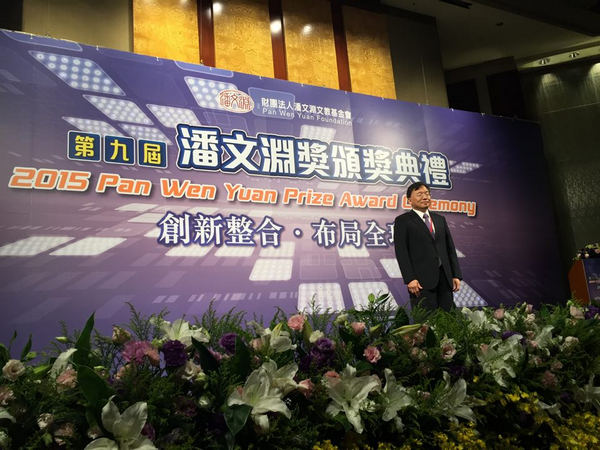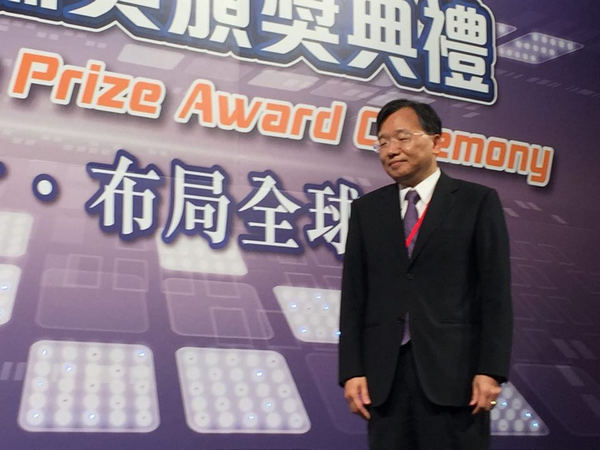Epistar has come a long way from its foundation in 1996 to become one of the largest players in Taiwan’s LED industry, mergers and acquisitions played a significant role in the process of building up the company. The company Chairman B.J. Lee shared some insights on the company’s business strategies at the 2015 Pan Wen Yuan Prize Award Ceremony on Monday, which took place at the Shangri-La Hotel in Taipei.
Lee highlighted three main goals achieved through Epistar’s merger strategies: acquiring technology know-how, building up production capacity, and transforming its existing business models.
 |
|
Epistar Chiarman B.J. Lee standing at the 2015 Pan Wen Yuan Prize Award Cermony stage before receiving his award. (All photos courtesy of LEDinside) |
“The first two acquisitions Epistar made including United Epitaxy Company and Highlink Technology in 2006, were made mostly out of the need to acquire new technology, while later absorption of Huga Optotech and FOREPI are aimed to build up the company size”, said Lee.
Most of the early mergers were focused on horizontal integration, where companies making similar products from the same industries were merged into Epistar. In recent years, though, vertical integration has become increasingly important in the industry, he said. It will be increasingly difficult for companies to go solo.
 |
|
Epistar Chiarman B.J. Lee. |
However, mergers can create financial challenges and management issues that require a long time to sort out, said Lee. “Integrating different company cultures, and situations where senior employees might reject new members joining the company, are two of the most difficult aspects in mergers. In any merger, we usually see 10% to 15% of the work force from the newly acquired company leave.”
In certain cases, the company strategy might also create difficult issues. When the company merged with South Epitaxy, Epistar replaced all its existing MOCVD and other LED making equipment with South Epitaxy manufacturing equipment.
Epistar has merged with six companies over the past decade, including United Epitaxy Company, TSMC SSL and FOREPI.
Taiwan’s business acquisition laws has also made it difficult for companies to acquire new businesses, admitted Lee. Laws in Taiwan have barred larger profiting companies from absorbing financially struggling companies, significantly raising merger costs.

Epistar Chiarman B.J. Lee being interviewed by reporters.
Preferring to save up on cash reservoir, Epistar’s business strategy in recent years is shifting into the realm of virtual vertical integration instead of picking up smaller companies. Under this model, Epistar collaborates with clients and suppliers to achieve an integrated supply chain.
Another strategy Epistar has implemented in recent years is forming patent alliances with leading LED companies including Lumileds, Cree and Toyoda Gosei. The company has signed LED cross-patent license agreements with all three companies, and set up a joint venture with Toyoda Gosei. “The difficult part in alliances is maintaining your distance with other alliance members, especially since some are your direct competitors,” said Lee. “Profit allocation to partners can also be difficult.”
At the moment Epistar is evaluating whether it wants to collaborate with certain electronic component makers in the U.S., as the company eyes the GaN driver market. In an earlier interview in October, Carson Hsieh, Vice President, R&D Center at the company mentioned notebook adaptors was a market it was looking into for GaN driver applications. Lee did not reveal which companies Epistar has approached, but said the move was crucial to its business transformation.
The company’s approach to the electronic component industry will be very different from the LED, where it has established a name for itself. Epistar is relatively a new player in the electronic component industry, and is seeking for suitable partners that have the technology know-how.
“We want to move away from being just a component supplier in the electronic component industry,” said Lee. “We want to be able to bring the end product to consumers, and have a comprehensive supply chain.”
Epistar might even consider spinning off its electronic component device R&D team into a separate company that is financially backed by the LED maker, said Lee. The possibility is there.
Asked about his perspective on the halted sell of competitor Lumileds to Go Scale Capital, Lee declined to comment whether the case would proceed or not. Saying rumors on the market have pointed to the Committee on Foreign Investment in the United States (CFIUS) has classified information related to its decision making process as confidential. However, Lee believes the case put on hold could create a favorable situation and various opportunities for Taiwanese LED manufacturers.
(Author: Judy Lin, Chief Editor, LEDinside)














